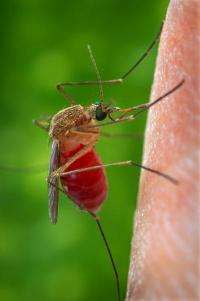Researchers sequence genome of mosquito that spreads West Nile virus

Last year, 720 people in the United States became infected with West Nile virus, a potentially serious illness that is spread through the bite of a mosquito - the Culex mosquito - that has first fed on infected birds. Such mosquitoes have the virus eventually located in their salivary glands and transmit the disease to humans and animals when they bite to draw blood.
To understand the genetic makeup of the Culex mosquito, and how the insect is able to transmit this and other viruses, an international team of scientists, led by geneticists at the University of California, Riverside, has sequenced the genome of Culex quinquefasciatus, a representative of the Culex genus (or group) of mosquitoes.
A close study of the genome, the researchers say, could give scientists the clues they need to target specific Culex genes that are involved in the transmission of West Nile virus, St. Louis encephalitis, lymphatic filariasis and other diseases spread by the Culex group of mosquitoes. Knowledge of such genes would be an important step in developing strategies to combat the spread of these pathogens.
The genomes of Anopheles gambiae (which transmits malaria) and Aedes aegypti (which transmits yellow fever and dengue) were published in 2002 and 2007, respectively. Now, with the sequencing of Culex quinquefasciatus, scientists have completed the triangulation of entire genome sequences of three genera of mosquitoes that are the main vectors of deadly human diseases, and will have access to representative genomes from the three mosquito groups.
"We can now compare and contrast all three mosquito genomes, and identify not only their common genes but also what is unique to each mosquito," said Peter Arensburger, an assistant research entomologist in the Center for Disease Vector Research and the Department of Entomology, who led the substantial bioinformatics component of the multiyear research effort. "Moreover, now that we have sequenced the Culex genome, we can begin to identify which mosquito genes get turned on or turned off in response to infection - knowledge that is critical to developing strategies for preventing the transmission of West Nile virus and other disease vectors."
Study results appear in the Oct. 1 issue of Science.
The researchers report that Culex quinquefasciatus, also known as the southern house mosquito, has a genome size of 579 million nucleotides, which is intermediate between the genome sizes of Anopheles gambiae (278 million nucleotides) and Aedes aegypti (about 1380 million nucleotides). However, Culex quinquefasciatus has a higher number of genes (18,883 genes) than Anopheles gambiae (12,457 genes) or Aedes aegypti (15,419 genes).
"We do not know why this is the case," said Arensburger. "Culex quinquefasciatus is very widely distributed throughout the globe; the same species is found in California and South Africa. It is possible that the large number of genes in this mosquito helped it survive in a wide variety of habitats."
The researchers also report that the genome for Culex quinquefasciatus bears more similarity to the Aedes aegypti genome than the Anopheles gambiae genome.
Thirty-seven institutions collaborated with UC Riverside on the research project that began in 2004. Besides Arensburger, the UCR team includes Peter Atkinson, the director of the Center for Disease Vector Research and a professor of entomology, and Alexander Raikhel, a distinguished professor of entomology.
"We coordinated with researchers around the world to accomplish the sequencing of the Culex genome," said Atkinson, the senior author of the study and the principal investigator of the grants that funded UCR's contribution to the research. "We could not have done this without the outstanding computing support we received from UCR's Institute for Integrative Genome Biology. It enabled us to perform vast and complex analyses here on campus, and gave us the confidence to get the project going and completed."
With more than 1,200 described species, Culex is the most diverse and geographically widespread of the three mosquito genera. The adult mosquito measures 4-10 millimeters. Only females spread disease. Culex-transmitted diseases, such as West Nile virus, are difficult to eradicate because birds and animals the mosquito feeds on are mobile, capable of spreading disease quickly over large areas.
West Nile virus first appeared in the United States in the summer of 1999. Since then it has been found in all 48 contiguous states.
The research paper in Science is accompanied by a second paper, led by researchers at Boston College, Mass., and Iowa State University, that focuses on a set of immune genes in Culex quinquefasciatus. The paper explores why some of these genes are "upregulated" (show an increase in gene expression) while others are "downregulated" in response to pathogens. Arensburger, Atkinson and Raikhel are coauthors on the companion paper in the same issue of Science on Culex immunobiology with Raikhel's laboratory contributing significantly to this work.
With the sequencing of the Culex quinquefasciatus genome completed, UCR researchers will focus next on genes of particular interest to efforts aimed at preventing the spread of human diseases by these mosquitoes.
Provided by University of California -- Riverside

















